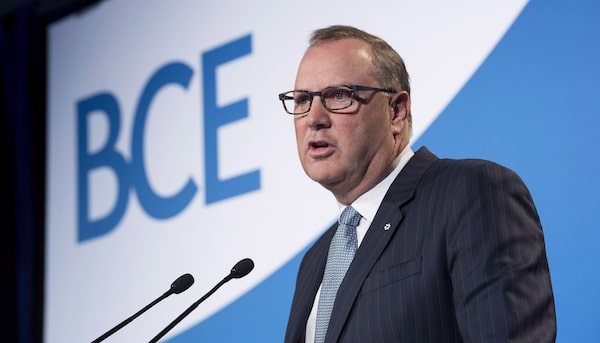
George Cope, president and CEO of BCE Inc., expects his company will be able to use Huawei 5G gear in non-core parts of its networks.Paul Chiasson/The Canadian Press
George Cope is optimistic BCE Inc. will be able to use Huawei equipment to build 5G wireless networks when Ottawa’s cybersecurity review of the Chinese company concludes.
The BCE chief executive officer says he believes it makes sense to restrict the use of Huawei gear to non-core parts of the network, an approach that is gaining some traction in Europe even as the United States continues to press its allies not to use the technology over concerns it could be used to conduct spying for the Chinese government.
The federal government is conducting a national security review of Huawei Technologies Co. Ltd. and earlier this week, Public Safety Minister Ralph Goodale said he expects a cabinet decision on the issue before the election in October.
That ruling will be crucial for BCE and Telus Corp., Canada’s second- and third-largest wireless carriers, which have used Huawei gear extensively in their existing radio access networks (which include the antennas and radios on cell towers) and have not yet selected equipment vendors for 5G.
“In the end, on Huawei, my instincts would be that it will be [banned in] the core, which is what most of the other countries are talking about,” Mr. Cope said in an interview with The Globe and Mail on Thursday. “We’ve always supported that view because that’s been our view since we started to use Huawei.”
Huawei has had a presence in Canadian networks for the past decade and BCE says it has followed government requirements to use the Chinese company’s equipment only in the radio access portion of its networks, which lie outside the “core” of the network where sensitive information is stored. Mr. Cope said BCE’s position to the government has been that it makes sense to maintain that distinction for 5G, or fifth-generation, wireless technology.
“We know what the U.S. is going to do," he said, referring to expectations that the Trump administration will implement an outright ban of Huawei equipment. "I think what’s changed a little bit is people are looking at it quite seriously in Europe and saying maybe it is core versus non-core,” he said. Mr. Cope referenced public comments made by chief technology officers of European wireless providers that support continued use of Huawei equipment in some way.
Last week, leaked details from private government discussions in Britain indicated that the government of Prime Minister Theresa May had decided to let Huawei participate, with certain restrictions, in 5G networks.
But some security experts have cautioned that with 5G technology, which relies on a more distributed network with many access points, it will be more difficult to draw a clear distinction between the core and less-sensitive parts of networks.
The Globe has previously reported that BCE has used Huawei network equipment to build about 60 per cent to 70 per cent of its existing radio network, while Telus has built virtually 100 per cent of its radio network using Huawei equipment. Rogers Communications Inc. has relied primarily on Swedish vendor Ericsson and has said it will continue that partnership for its 5G build.
Huawei, the world’s largest telecom network supplier, broke into the Canadian market in part by offering lower prices than its European rivals, though the price gap has since narrowed.
Partners such as BCE and Telus also praise the Chinese company’s technology and it is seen as a leader on 5G equipment. However, some critics charge that Huawei has gained an edge in part through research partnerships with Canadian universities that see patents assigned to the company and taxpayer-funded research flow out of the country.
Canadian carriers are expected to begin building 5G networks over the next few years, with many investments tied to the availability of wireless airwaves known as spectrum. The government announced the results of its first auction of 5G spectrum last month and BCE surprised observers by walking away with no licences for the 600-megahertz airwaves while Telus spent more than $900-million and Rogers invested $1.7-billion.
During a conference call with analysts Thursday morning after BCE reported its first-quarter financial results, Mr. Cope said the company is more focused on spectrum the government plans to sell in next year’s auction, which is in the 3.5-gigahertz frequency range and is expected to be widely used for 5G.
“It wasn’t for us cost-effective to purchase [600 MHz spectrum],” Mr. Cope said, adding that the company determined it could spend less to improve its network by adding more new cell sites. “The 3.5 spectrum auction is much more strategic for us.”
BCE said Thursday that profit increased by 12 per cent to $740-million, or 82 cents a share, up from $661-million or 73 cents a share in the same period last year.
On an adjusted basis, it earned 77 cents a share, missing analyst forecasts for 78 cents. Revenue increased by 2.6 per cent to $5.73-billion and EBITDA (earnings before interest, taxes, depreciation and amortization) grew by 6.9 per cent to $2.4-billion.
BCE added 50,204 wireless customers on contracts during the first quarter, down from 68,487 last year but just ahead of analyst forecasts in the range of 47,000.
At its residential business, the company added 22,671 internet customers, up from 18,156 this time last year. It also attracted 20,916 IPTV (internet protocol television) subscribers, up more than 50 per cent from 13,573 in the first quarter of 2018 (though BCE continues to shed satellite TV customers).